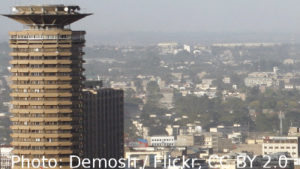
From 28 November to 1 December, several thousand people gathered in Nairobi for the second High-Level Meeting (HLM) of the Global Partnership for Effective Development Cooperation (GPEDC). The first meeting was held in Mexico City 18 months ago. The question is: was the second meeting a success?
Size doesn’t matter: in search of a narrative
If the length of the outcome document may be taken as a gauge of success, the Nairobi HLM was indeed fairly successful. The document devotes a total of 23 pages (40 even, including the annex) highlighting the commitments made at the meeting. However, it is hard to pinpoint any commitments that might require clear follow-up processes. The actors commit to hardly any concrete, measurable next steps. It would be difficult for any development cooperation provider or partner country to design a concrete follow-up process based on the outcome of the HLM.
At the same time, there is a need for a global platform on effective development cooperation. Indeed, the GPEDC’s rationale remains fully valid: “The Global Partnership (…) seeks to maximize the effectiveness and impact of all forms of cooperation for development” (Outcome document, p. 1). It sees its role in contributing to the UN High Level Political Forum (HLPF), which is the main platform for follow-up action on the Agenda 2030 for Sustainable Development. Thus, the GPEDC’s most important role is:
- to set standards for all development cooperation actors;
- to monitor the implementation of these standards.
Both of these are needed. Both have yet to come.
Perceptions have an impact
The GPEDC’s most important innovation is its multi-stakeholder approach. In fact, it includes all relevant actors such as members of parliament, civil-society organisations, the private sector, think tanks and academics, in addition to government representatives. Yes, all these actors raised their voices and yes, they were heard. And for sure, the GPEDC does not follow the overly balanced, diplomatic approaches adopted by a number of UN platforms. In other words, at least the non-plenary sessions and side-events provided scope for creative and controversial – and often constructive – debate.
However, even though all countries were invited to attend the HLM, several governments preferred not to attend or just to be present as observers. As was the case at the first HLM in Mexico City, Brazil, China and India did not show up. South Africa also decided not to attend the HLM on its own continent. As in 2014, this sensitive issue was not a topic on the main agenda of the plenary session. But it was discussed in side-events where think tank representatives from all the above countries helped to foster a better understanding of their respective reasons for not attending.
Emerging Powers were absent on GPEDC
The absence of four of the five BRICS, i.e. Brazil, Russia, India, China and South Africa (only Russia attended), is a clear signal and has had a big impact on the ‘global nature’ of the partnership.
So why did a number of emerging powers decide to stay away? There are likely to have been two main perceptions. Perception one: the GPEDC is still considered as OECD-driven. Sseveral emerging powers do not recognise the GPEDC as a legitimate platform for debating global development. Perception two: the fact that the GPEDC is facilitated jointly by UNDP and the OECD means that there is a good basis for a widely accepted platform. However, the problem might rather be a limited degree of willingness to bring in more transparency and accountability for South-South cooperation.
Leadership aspects
Most of the preparatory work for the Nairobi HLM was done by the three co-chairs from Malawi, Mexico and the Netherlands. As planned, the three co-chairs will now rotate for the next two years. Uganda will act as the representative of ‘recipients of development co-operation’; Bangladesh will represent ‘recipients and providers of development co-operation’; and Germany will be the representative of ‘providers of development co-operation’. Informal discussions revealed that a number of actors are in favour of proactive co-chairs who might seek to pursue an intensive dialogue with emerging powers about their views on the future of the GPEDC. There is also a need to link up more closely with UN processes (including the HLPF and the Financing for Development activities).
Based on the discussions about the outcome document, the GPEDC’s steering committee might approve the establishment of a non-executive co-chair position for a non-state representative of a broad spectrum of constituencies including civil-society organisations, trade unions, local governments, parliaments, philanthropy and the private sector.
The way ahead
In our view, the case needs to be made for a global platform in charge of standards for development cooperation. This includes South-South cooperation and the OECD’s Official Development Assistance. It is pretty clear what homework needs to be done first:
- the GPEDC’s narrative needs to be more specific;
- an open, serious dialogue with emerging powers about their perceptions and positions is long overdue.

Schreibe einen Kommentar